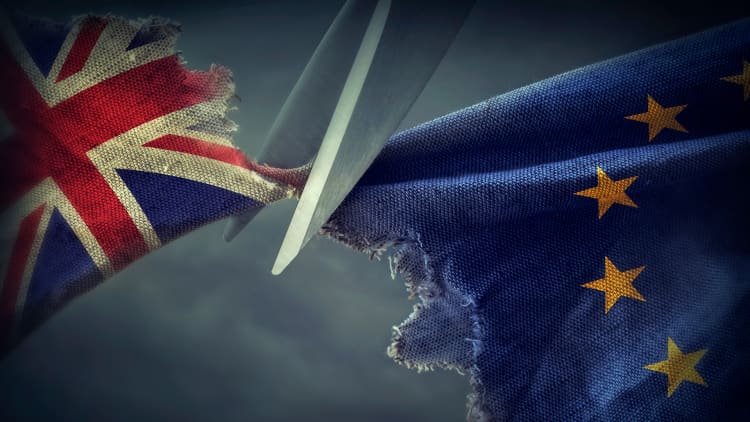The nature of the Irish border post-Brexit has been a major sticking point in negotiations between the British government and the European Union.
Both sides agree, whatever the outcome of Brexit, that checks along the Irish border must be avoided.
But, with 15 days to go before the world's fifth-largest economy is scheduled to leave the bloc, Brexit negotiators have been unable to reach a consensus on the terms.
It is a matter of great political and diplomatic sensitivity, with the 310-mile frontier set to represent the only land border between the U.K. and the EU from October 31.
What does a backstop mean?
A position of last resort, the controversial "backstop" plan is essentially a legally-binding insurance policy.
It is designed to ensure there is no hard border between the U.K. province of Northern Ireland and the Republic of Ireland whatever the outcome of future trade talks between the U.K. and the EU.
The backstop plan, which the EU has insisted must be part of any Brexit deal, would involve the U.K. maintaining a very close relationship with the bloc for an indefinite period.
It would apply if the U.K. failed to agree on a final deal at the end of a transition period, or if that final deal does not guarantee a soft border.
It would not apply if Britain leaves without a deal.
Why does it matter?
There is a broad consensus across the U.K. and the EU that the Irish border must remain as open as possible, amid fears Brexit could reignite tensions behind "The Troubles" — a 30-year conflict over Northern Ireland's status as part of the U.K.
Presently, there are no customs or regulatory checks on goods passing between Northern Ireland and the Republic of Ireland.
That's because the EU's single market and customs union arrangements make it easy for people, goods and services to cross the border, with both nations following a similar set of rules and regulations.
But, after Brexit, that could all change. The two parts of the island of Ireland could be in different customs and regulatory regimes. This, in turn, could lead to an increase in safety checks, delays and surveillance at crossing points.
British Prime Minister Boris Johnson has said a revised Brexit deal must include the "abolition" of the backstop. The former London mayor has warned the policy would mean "signing away" the U.K.'s economic independence.
Many lawmakers from the ruling Conservative Party fear the backstop plan could be used to permanently trap the U.K. in the EU's customs union, preventing the country from negotiating its own trade deals.
Instead, some Members of Parliament (MPs) have called for either a strict time limit on the backstop or a measure which would allow the U.K. to unilaterally end it.
Opposition to the backstop eventually led to the resignation of Prime Minister Theresa May earlier this year.
How does it work exactly?
Initially, the backstop required Northern Ireland to be kept very closely aligned to EU customs laws in order to remove the need for physical infrastructure on the Irish border post-Brexit.
The version of the Withdrawal Agreement, signed by Theresa May in November 2018, expanded this deal to cover the whole of the U.K. — at the insistence of the Democratic Unionist Party (DUP).
The DUP, which had propped up May's Conservative minority government in Westminster, strongly objected to the possibility of a virtual border between Northern Ireland and the rest of the U.K.
May's successor no longer enjoys the same majority.
This turn of events has prompted some senior government ministers to publicly hint that a backstop that only applies to Northern Ireland may now be the best option left open to Downing Street — if Johnson is to fulfill his promise of leaving the world's largest trading bloc by Oct. 31.
Johnson has since ruled out of the idea of a Northern Ireland-only backstop, telling viewers of a Facebook live that this option "simply doesn't work for the U.K."

Under the current text of the Withdrawal Agreement, the backstop policy would be invoked at the end of a transition period in 2020.
The clause is designed as a default mechanism to remain in place until an alternative arrangement has been agreed.
Where do we go from here?
On the eve of a crucial two-day summit of EU leaders in Brussels, Johnson appears to have the basis of a deal with the European Commission after making major concessions to Brussels over the Irish border.
It is understood that Johnson's new plan would create a customs border down the Irish Sea — a notion which his predecessor had previously said "no British prime minister" could accept.
This would, in effect, put a regulatory border between Northern Ireland and Britain. Goods from mainland Britain would need to be checked to make sure they conform to EU standards, with Northern Ireland still part of the European single market in such a scenario.
The DUP, which is reportedly unhappy with the new plans, said Tuesday that more work was needed before it would support a deal and insisted Northern Ireland must remain in a customs union with the U.K.
A two-day summit of EU leaders begins in Brussels on Thursday. It is the last such meeting currently scheduled before the fast-approaching Brexit deadline.
The U.K. is due to leave the EU at 11 p.m. London time on Oct. 31.
— Reuters contributed to this report.


